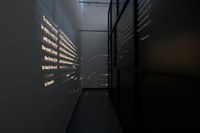Of Other Worlds That Are In This One




Description
'Of Other Worlds that Are in this One' was first shown at the São Paulo Biennial in 2014 and developed further in Chakar’s major solo exhibition 'On Becoming Two' at Beirut Art Centre in 2017. A metal wall holds images of strangers that Chakar discovered by coincidence through facial recognition software in photographs of empty cityscapes taken during his travels. The randomness of the software, and its regular failure to distinguish a human face from an object, show an irrationality in the midst of what is considered the most rational of all human constructs. Chakar identified them as ‘moments of vision’ – as mystics might describe them. They appear as ruptures in the fabric of our world that might allow insight into ‘another world that is in this one’. The images are combined with texts from esoteric writings – Muslim, Gnostic Christian and Kabballah mysticism – which are cut out of the metal wall and thus become negative tracts. The light from the exhibition space projects the texts on the wall behind the metal, creating a game of light and shadow in the narrow corridor behind that disturbs the cold, sharp logic of the materials.
Tony Chakar lives and works in Beirut. Since 1999 he has developed projects that address the complex social and political histories of his hometown and region. The material evidence of war and conflict that have stood in the city since the Lebanese Civil War 1975-1990, are intersected by jarring moments of renewal and gentrification – as though everything is happening simultaneously. Against this background, Chakar explores the idea and reality of public space and how different temporalities and communities come to recognise and use it. The religious complexity of Lebanon also leaves its mark on the work, as the world’s major monotheist religions still battle it out for supremacy in the region. In the works in the exhibition, he uses language, images and architectural forms to create a bodily experience of narrative where time is out of joint and modernity meets its limits.
![[object Object]](/en/collection-research/library/publications/out-of-beirut/@@fallback-image/image/large)
![[object Object]](/en/exhibitions/tony-chakar-as-in-a-beginning/@@fallback-image/image/large)